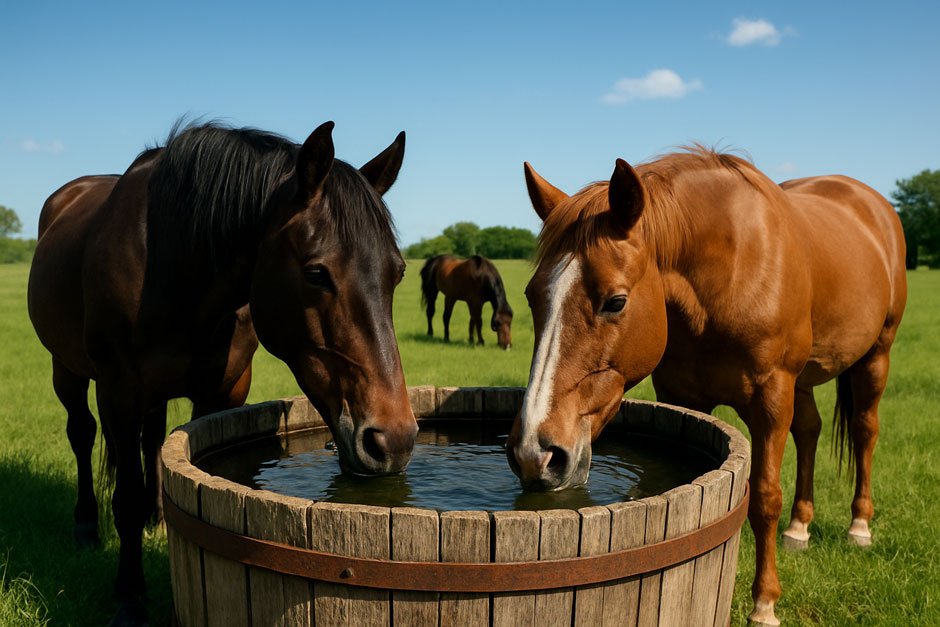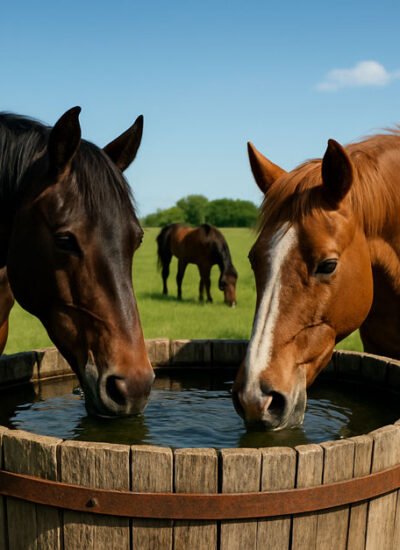 Introduction: More Than Just a Water Container
Introduction: More Than Just a Water Container
The horse trough, often seen as a simple fixture in rural landscapes, holds a significant place in the history of animal husbandry and continues to be an indispensable tool for equine care. Beyond its basic function as a water receptacle, it represents a commitment to the well-being of horses, ensuring they have constant access to one of life’s most vital resources.
Proper hydration is paramount for a horse’s health, impacting everything from digestion and nutrient absorption to temperature regulation and overall performance. A well-maintained horse trough is therefore not merely a container, but a cornerstone of responsible horse ownership, safeguarding against dehydration and its associated health complications.
A Journey Through Time: The History of Horse Troughs
The origins of watering troughs can be traced back to ancient times, evolving from natural depressions or simple carved stones to more sophisticated structures. In the pre-industrial era, when horses were the primary mode of transport and labor, these troughs were ubiquitous in towns and cities, serving as essential
watering stations for weary animals. The Metropolitan Drinking Fountain and Cattle Trough Association, formed in 1867 in London, is a testament to their historical importance, having established over a thousand cattle troughs, many of which were in London itself [1]. These were often described as ‘Victorian filling stations,’ crucial for Hansom cab drivers and other horse-drawn transport operators.
Notable philanthropic efforts, such as those by Annis and George Bills in 1927, led to the funding and construction of hundreds of watering troughs across Australia, Ireland, England, and the United States. Many of these historical Bills horse troughs can still be found today, bearing inscriptions of their generous donation [2]. The transition from horse-powered transport to motorized vehicles in the early 20th century gradually reduced the urban need for these public troughs, but their legacy endures in rural settings and as historical landmarks.
Essential Hydration: Why Horse Troughs Matter
Providing horses with constant access to fresh, clean water is fundamental to their health and welfare. A horse’s body is composed of approximately 70% water, and even a slight reduction in hydration can significantly impair physiological functions. Water troughs serve as a reliable source, ensuring that horses can drink whenever they need to, especially after exertion or during hot weather.
Monitoring a horse’s water intake is another critical aspect facilitated by troughs. While it might seem straightforward, observing how much water a horse consumes can provide early indicators of health issues. Dehydration can lead to a range of serious problems, including digestive complications like colic, reduced appetite, lethargy, and in severe cases, organ failure. A consistent water supply from a trough helps prevent these conditions, contributing to the horse’s overall vitality and longevity.
Diverse Designs: Materials and Types of Horse Troughs
The evolution of horse troughs has led to a variety of designs and materials, each offering distinct advantages and considerations for horse owners. Traditional materials have long been favored for their practicality and durability, while modern innovations continue to enhance efficiency and ease of maintenance.
Traditional Materials
Galvanized Metal: These troughs are renowned for their sturdiness and durability, often lasting for many years. They are typically available in larger capacities, making them suitable for multiple horses or larger breeds. However, metal troughs can be susceptible to rust if not properly maintained, and in colder climates, water within them can freeze more readily, requiring diligent ice-breaking efforts.
Plastic: Lightweight and generally more affordable, plastic troughs are easy to move and install. They are resistant to rust and corrosion and do not conduct heat as readily as metal, which can be beneficial in some climates. Nevertheless, plastic can be less durable than metal, prone to cracking in extreme cold, and may not always be available in very large sizes.
Rubber: Offering a balance between durability and flexibility, rubber troughs are robust and less likely to crack than plastic. They are also lighter than metal, simplifying relocation. However, rubber troughs can be more expensive than both plastic and metal alternatives, and their installation might present unique challenges.
Modern Innovations
Automatic Waterers: These systems provide a continuous supply of fresh water, automatically refilling as horses drink. Equipped with float valves, they maintain an ideal water level, preventing overflow and reducing water wastage. Automatic waterers are particularly beneficial for busy owners, ensuring consistent hydration without constant manual checks.
Insulated Troughs: Designed to combat freezing temperatures, insulated troughs help prevent water from turning to ice in winter months. This feature is crucial for ensuring horses have uninterrupted access to water, mitigating the need for daily ice-breaking. Some models can also help keep water cooler in summer.
Solar-Powered Options: Embracing sustainability, solar-powered troughs utilize renewable energy to operate features like heating elements or automatic pumps. These eco-friendly solutions can reduce electricity costs and offer a viable option for remote locations without easy access to power grids, promoting both environmental responsibility and convenience.
The Practicalities: Pros and Cons of Horse Troughs
While horse troughs are essential, understanding their practical advantages and disadvantages is crucial for making informed decisions about equine hydration.
Advantages
For many horse owners, the initial cost-effectiveness of basic horse troughs is a significant draw. Simple plastic or galvanized models are readily available and can be a budget-friendly option for providing water. They also offer a straightforward method for monitoring water levels, allowing owners to easily gauge how much their horses are drinking, which is vital for health assessment.
Furthermore, the simplicity in design of traditional troughs means fewer mechanical parts that can break down, leading to reliable operation. This straightforward approach has made them a staple in equine care for centuries, proving their enduring utility in various settings.
Disadvantages
Despite their benefits, horse troughs come with several challenges. Temperature regulation is a major concern; water can freeze solid in winter, necessitating daily ice-breaking, or become uncomfortably warm in summer, discouraging horses from drinking adequately. These temperature extremes can lead to dehydration or discomfort.
Maintenance is another significant drawback. Troughs require frequent cleaning to prevent the buildup of algae, debris, and other contaminants. This can be a time-consuming task, especially in warmer months when algae growth is rapid. The constant need for scrubbing and refilling adds to the daily workload of horse care.
Finally, the risk of water-borne illnesses is a serious consideration. Stagnant water in troughs can become a breeding ground for bacteria, parasites, and insects like mosquitoes, which can transmit diseases such as West Nile Virus. Blue-green algae, if present, can also produce toxins harmful to horses. Vigilant cleaning and water quality management are therefore paramount to mitigate these health risks.
Choosing the Right Trough: Factors to Consider
Selecting the appropriate horse trough involves evaluating several key factors to ensure it meets the specific needs of both the horses and their caretakers. The ideal choice will balance practicality, durability, and cost-effectiveness with the unique demands of the environment.
Consider the number of horses that will be using the trough and their size. Larger herds or bigger horses will require troughs with greater capacity to ensure an adequate water supply throughout the day. The climate and environmental conditions are also crucial; regions with harsh winters might benefit from insulated or heated troughs, while those with hot summers could prioritize features that keep water cool.
Budget and maintenance commitment play a significant role in the decision-making process. While some advanced troughs offer convenience, they often come with a higher initial cost and potential for more complex upkeep. Finally, the location and installation of the trough should be planned carefully, considering accessibility for cleaning, refilling, and potential power sources for automated systems.
Maintaining Optimal Health: Trough Care and Best Practices
Effective maintenance of horse troughs is vital for ensuring a continuous supply of clean, fresh water, which directly impacts equine health. Regular care routines can prevent many common issues associated with water quality.
Regular cleaning and disinfection are paramount. Troughs should be scrubbed thoroughly and disinfected periodically to remove algae, bacteria, and biofilm. The frequency will depend on factors like weather, the number of horses, and the trough material. Strategies for managing water in extreme temperatures are also important. In winter, heaters or insulated troughs can prevent freezing, while in summer, placing troughs in shade or frequent refills can help keep water cool and discourage algae growth.
Beyond physical cleaning, monitoring water quality is essential. Regularly checking for unusual odors, discoloration, or the presence of debris can help identify potential problems early. Ensuring a clean and accessible water source is one of the most fundamental yet impactful aspects of responsible horse care, contributing significantly to their overall well-being and performance.
Conclusion: The Enduring Role of the Horse Trough
The horse trough, from its humble beginnings as a simple watering point to its modern, technologically advanced iterations, has consistently played a critical role in equine welfare. Its evolution reflects a continuous effort to provide horses with essential hydration, adapting to changing needs and environmental challenges.
Today, whether a traditional galvanized tank or an automated, solar-powered system, the horse trough remains a symbol of responsible animal husbandry. Its enduring presence underscores the fundamental importance of clean water for the health, vitality, and performance of horses, ensuring their well-being for generations to come.




Leave a Reply